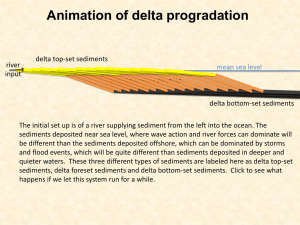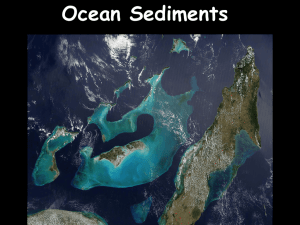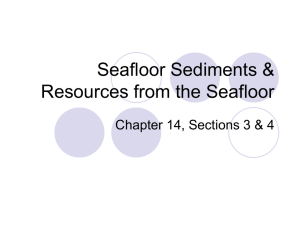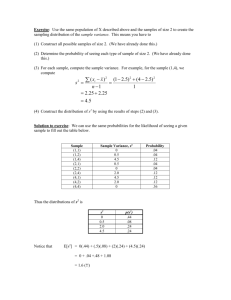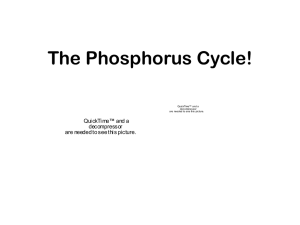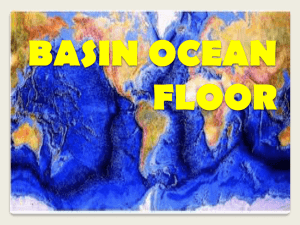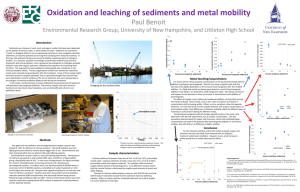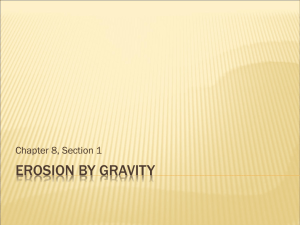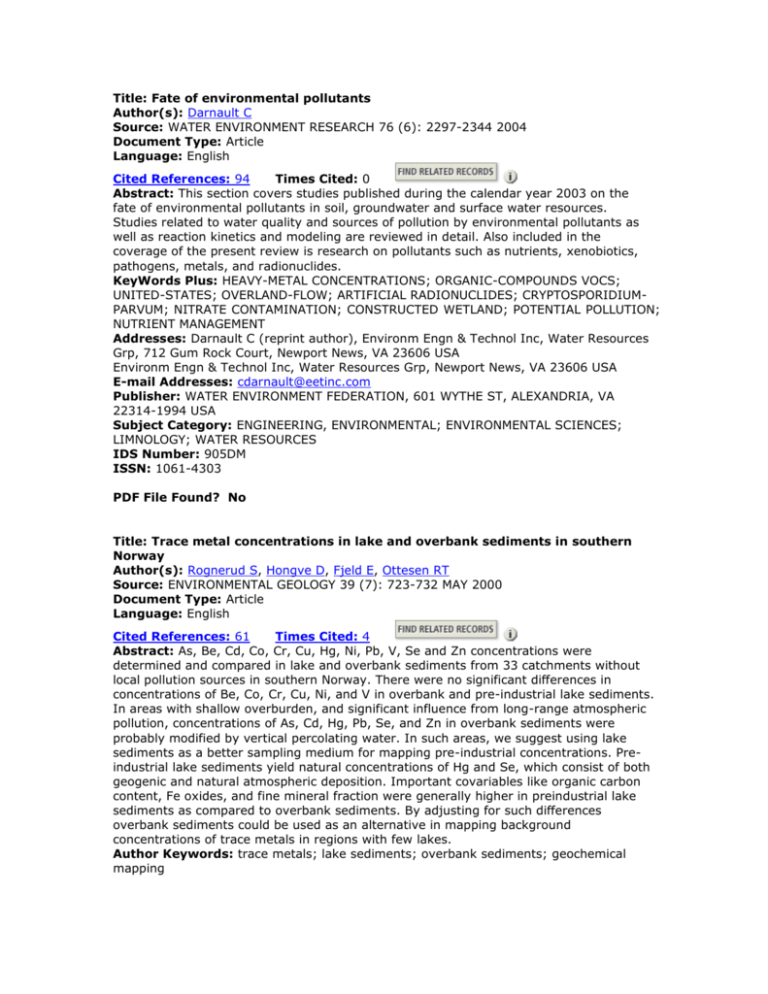
Title: Fate of environmental pollutants
Author(s): Darnault C
Source: WATER ENVIRONMENT RESEARCH 76 (6): 2297-2344 2004
Document Type: Article
Language: English
Cited References: 94
Times Cited: 0
Abstract: This section covers studies published during the calendar year 2003 on the
fate of environmental pollutants in soil, groundwater and surface water resources.
Studies related to water quality and sources of pollution by environmental pollutants as
well as reaction kinetics and modeling are reviewed in detail. Also included in the
coverage of the present review is research on pollutants such as nutrients, xenobiotics,
pathogens, metals, and radionuclides.
KeyWords Plus: HEAVY-METAL CONCENTRATIONS; ORGANIC-COMPOUNDS VOCS;
UNITED-STATES; OVERLAND-FLOW; ARTIFICIAL RADIONUCLIDES; CRYPTOSPORIDIUMPARVUM; NITRATE CONTAMINATION; CONSTRUCTED WETLAND; POTENTIAL POLLUTION;
NUTRIENT MANAGEMENT
Addresses: Darnault C (reprint author), Environm Engn & Technol Inc, Water Resources
Grp, 712 Gum Rock Court, Newport News, VA 23606 USA
Environm Engn & Technol Inc, Water Resources Grp, Newport News, VA 23606 USA
E-mail Addresses: cdarnault@eetinc.com
Publisher: WATER ENVIRONMENT FEDERATION, 601 WYTHE ST, ALEXANDRIA, VA
22314-1994 USA
Subject Category: ENGINEERING, ENVIRONMENTAL; ENVIRONMENTAL SCIENCES;
LIMNOLOGY; WATER RESOURCES
IDS Number: 905DM
ISSN: 1061-4303
PDF File Found? No
Title: Trace metal concentrations in lake and overbank sediments in southern
Norway
Author(s): Rognerud S, Hongve D, Fjeld E, Ottesen RT
Source: ENVIRONMENTAL GEOLOGY 39 (7): 723-732 MAY 2000
Document Type: Article
Language: English
Cited References: 61
Times Cited: 4
Abstract: As, Be, Cd, Co, Cr, Cu, Hg, Ni, Pb, V, Se and Zn concentrations were
determined and compared in lake and overbank sediments from 33 catchments without
local pollution sources in southern Norway. There were no significant differences in
concentrations of Be, Co, Cr, Cu, Ni, and V in overbank and pre-industrial lake sediments.
In areas with shallow overburden, and significant influence from long-range atmospheric
pollution, concentrations of As, Cd, Hg, Pb, Se, and Zn in overbank sediments were
probably modified by vertical percolating water. In such areas, we suggest using lake
sediments as a better sampling medium for mapping pre-industrial concentrations. Preindustrial lake sediments yield natural concentrations of Hg and Se, which consist of both
geogenic and natural atmospheric deposition. Important covariables like organic carbon
content, Fe oxides, and fine mineral fraction were generally higher in preindustrial lake
sediments as compared to overbank sediments. By adjusting for such differences
overbank sediments could be used as an alternative in mapping background
concentrations of trace metals in regions with few lakes.
Author Keywords: trace metals; lake sediments; overbank sediments; geochemical
mapping
KeyWords Plus: REGIONAL GEOCHEMICAL DATA; ORGANIC-MATTER; FOREST FLOOR;
HEAVY-METALS; LEAD; DEPOSITION; LABRADOR; MERCURY; ELEMENTS; CANADA
Addresses: Rognerud S (reprint author), Norwegian Inst Water Res, Sandvikavelen 41,
Ottestad, N-2312 Norway
Norwegian Inst Water Res, Ottestad, N-2312 Norway
Natl Inst Publ Hlth, Oslo, N-0403 Norway
Norwegian Inst Water Res, Oslo, N-0411 Norway
Geol Survey Norway, Trondheim, N-7004 Norway
Publisher: SPRINGER VERLAG, 175 FIFTH AVE, NEW YORK, NY 10010 USA
Subject Category: GEOSCIENCES, MULTIDISCIPLINARY; ENVIRONMENTAL SCIENCES;
WATER RESOURCES
IDS Number: 323BY
ISSN: 0943-0105
PDF File Found? Yes
Title: Overbank sediments: a natural bed blending sampling medium for large scale geochemical mapping
Author(s): Bolviken B, Bogen J, Jartun M, Langedal M, Ottesen RT, Volden T
Source: CHEMOMETRICS AND INTELLIGENT LABORATORY SYSTEMS 74 (1): 183-199
NOV 28 2004
Document Type: Article
Language: English
Cited References: 48
Times Cited: 0
Abstract: Overbank sediments occur along rivers and streams with variable water
discharge. They are deposited on floodplains and levees from water suspension during
floods, when the discharge exceeds the amounts that can be contained within the normal
channel. Overbank sediments were introduced as a sampling medium in geochemical
mapping in 1989, and a number of studies have later been published on this subject.
These papers indicate:
1. Depth integrated samples of overbank sediments reflect the composition of many
current and past sediment sources upstream of the sampling point, contrary to active
stream sediments, which originate in a more restricted number of presently active
sediment sources from which they move regularly along the stream channel. In many
regions overbank sediments are more representative of drainage basins than active
stream sediments and can, therefore, be used to determine main regional to continental
geochemical distribution patterns with widely scattered sample sites at low cost per unit
area.
2. Samples of overbank sediments can be collected in floodplains or old terraces along
laterally stable or slowly migrating channels. In some locations the surface sediments
may be polluted, however, natural, pre-industrial sediments may, nevertheless, occur at
depth. Mapping of the composition of recent and pre-industrial overbank sediments can,
therefore, be used (i) in a characterization of the present state of pollution, and (ii) as a
regional prospecting tool in natural as well as polluted environments.
3. Vertical movements of elements in strata of overbank sediments may occur, especially
in cases where the distribution of relatively mobile elements in non-calcareous areas are
heavily influenced by acid rain. However, the overall impression is that vertical migration
of chemical elements is not a major problem in the use of overbank sediments in
geochemical mapping.
4. The composition of overbank sediment is of great interest to society in general, since
flood plains are very important for agriculture, urbanisation, and as sources for drinking
water.
Several of the above points indicate that overbank sediments represent a natural
analogue to the products of bed-blending. This aspect is mentioned here in light of the
Theory of Sampling (TOS). (C) 2004 Elsevier B.V. All rights reserved.
KeyWords Plus: KVINA DRAINAGE-BASIN; MINING ACTIVITIES; STREAM SEDIMENT;
LAKE SEDIMENT; NORWAY; BELGIUM; CONTAMINATION; EXPLORATION; FLOODPLAINS;
LUXEMBOURG
Addresses: Bolviken B (reprint author), Geol Survey Norway, Trondheim, NO-7491
Norway
Geol Survey Norway, Trondheim, NO-7491 Norway
Norwegian Water Resources & Energy Adm, Oslo, NO-0301 Norway
E-mail Addresses: bjorn.bolviken@ngu.no
Publisher: ELSEVIER SCIENCE BV, PO BOX 211, 1000 AE AMSTERDAM, NETHERLANDS
PDF File Found? Yes
Title: Reproducibility of overbank sediment sampling in Greece and Norway
Author(s): Demetriades A, Volden T
Source: JOURNAL OF GEOCHEMICAL EXPLORATION 59 (3): 209-217 SEP 1997
Document Type: Article
Language: English
Cited References: 17
Times Cited: 2
Abstract: Reproducibility of overbank sediment sampling was tested in twenty-nine
floodplains in Europe, ten in Greece and nineteen in Norway, by the collection of duplicate
pairs of samples. Distances between duplicate sites in Greece were 60 to 100 m, and in
Norway 100 to 200 m. In Norway the same nineteen floodplains were sampled by a
second team for the purpose of investigating differences in sampling variability and
technique. Total element contents were determined in all samples. Paired samples were
compared by calculating Spearman's rank correlation coefficient on the raw analytical
data, and one-way analysis of variance on the log-transformed data. Pairs of overbank
sediment samples collected from different floodplains by the Hellenic team and the first
Norwegian team showed high rank correlations and low within-basin variability (sampling
and analytical variance). Statistical results of the second Norwegian team were
comparatively poorer; both Spearman's rank correlation coefficient and one-way analysis
of variance, showed very low positive to negative correlations and high within-basin
variation, suggesting a non-uniform distribution of elements in the Norwegian overbank
sediment sequences and differences in the sampling technique of the two teams.
Nevertheless, careful location of sample sites, as has been done by the Hellenic and the
first Norwegian teams, reduces considerably the sampling variability, and the overall
sampling reproducibility for most elements is very good for distances up to 100 m in
Greece and 200 m in Norway, provided correlated overbank sediment sequences are
sampled. The implication of this study for multinational regional geochemical mapping is
that overbank sediment sampling must be carried out by well-trained professional teams
of exploration geochemists, and where possible by one sampling team for the whole
country. (C) 1997 Elsevier Science B.V.
Author Keywords: statistical analysis; overbank sediment; floodplains; regional
mapping; Greece; Norway
Addresses: Demetriades A (reprint author), INST GEOL & MINERAL EXPLORAT, 70
MESSOGHION ST, ATHENS, GR-11527 GREECE
GEOL SURVEY NORWAY, TRONDHEIM, N-7002 NORWAY
Publisher: ELSEVIER SCIENCE BV, PO BOX 211, 1000 AE AMSTERDAM, NETHERLANDS
Subject Category: GEOCHEMISTRY & GEOPHYSICS
IDS Number: YC670
ISSN: 0375-6742
PDF File Found? No
Title: Small-scale spatial and temporal variance in the concentration of heavy
metals in aquatic sediments: a review and some new concepts
Author(s): Birch GF, Taylor SE, Matthai C
Source: ENVIRONMENTAL POLLUTION 113 (3): 357-372 2001
Document Type: Article
Language: English
Cited References: 75
Times Cited: 5
Abstract: Uncertainty associated with data derived by the analyses of heavy metals in
aquatic sediment is due to variance produced in the laboratory (precision), plus 'natural',
small-scale spatial variance, (or field variance) at the sampling site. Precision is easily
determined and is usually reported in contaminant studies, but field variance is poorly
understood and seldom documented. It is important to have an understanding of the field
variance because if small-scale spatial variance in the concentration of heavy metals is
excessive, regional trends may be of limited value. Similarly, if temporal change is large,
the results of single synoptic surveys may be questionable and the ability to demonstrate
anthropogenic contributions over time will be difficult. However, it is evident from the
literature that the information needed to address problems of spatial and temporal
variance in the field is beyond the resources of most researchers. Analytical precision of
about 5% relative standard deviation (RSD) for heavy metal analysis is typical of a wellmanaged laboratory. Many studies of small-scale spatial variability made during the
current investigation indicate that field variance is related to ambient energy and to the
type of sedimentological environment. Total variance (analytical plus field variance) is
approximately 10% RSD (mean for a suite of nine trace elements) fur depositional parts
of estuaries and the marine environment, but increases to about 20-35% RSD for the
more dynamic parts of the estuarine environment and the fluvial system. Repeated
sampling over periods of up to 7 years undertaken during the present study, indicate a
similar order of magnitude for temporal variability in these sedimentological
environments. A proposed scheme to provide information on field variance is to
undertake small-scale spatial and temporal studies in discrete sedimentological
environments in the study area after sediment sampling and characterisation has been
completed. The comparatively large proportion of total variance associated with smallscale spatial and temporal variability in the field questions the often excessive cost and
effort made in attempting minor reductions in analytical precision in contaminant
investigations. (C) 2001 Elsevier Science Ltd. All rights reserved.
Author Keywords: small-scale spatial variance; small-scale temporal variance; field
variance; heavy metals; aquatic sediments
KeyWords Plus: SAN-FRANCISCO BAY; COASTAL SEDIMENTS; SIZE FRACTIONS;
TRACE-METALS; GRAIN-SIZE; SURFICIAL SEDIMENTS; MARINE-SEDIMENTS; SEVERN
ESTUARY; RIVER ESTUARY; AUSTRALIA
Addresses: Birch GF (reprint author), Univ Sydney, Sch Geosci, Environm Geol Grp,
Sydney, NSW 2006 Australia
Univ Sydney, Sch Geosci, Environm Geol Grp, Sydney, NSW 2006 Australia
Publisher: ELSEVIER SCI LTD, THE BOULEVARD, LANGFORD LANE, KIDLINGTON,
OXFORD OX5 1GB, OXON, ENGLAND
Subject Category: ENVIRONMENTAL SCIENCES
PDF File Found? Yes
Title: Small-scale spatial and temporal variance in the concentration of heavy
metals in aquatic sediments: a review and some new concepts
Author(s): Birch GF, Taylor SE, Matthai C
Source: ENVIRONMENTAL POLLUTION 113 (3): 357-372 2001
Document Type: Article
Language: English
Cited References: 75
Times Cited: 5
Abstract: Uncertainty associated with data derived by the analyses of heavy metals in
aquatic sediment is due to variance produced in the laboratory (precision), plus 'natural',
small-scale spatial variance, (or field variance) at the sampling site. Precision is easily
determined and is usually reported in contaminant studies, but field variance is poorly
understood and seldom documented. It is important to have an understanding of the field
variance because if small-scale spatial variance in the concentration of heavy metals is
excessive, regional trends may be of limited value. Similarly, if temporal change is large,
the results of single synoptic surveys may be questionable and the ability to demonstrate
anthropogenic contributions over time will be difficult. However, it is evident from the
literature that the information needed to address problems of spatial and temporal
variance in the field is beyond the resources of most researchers. Analytical precision of
about 5% relative standard deviation (RSD) for heavy metal analysis is typical of a wellmanaged laboratory. Many studies of small-scale spatial variability made during the
current investigation indicate that field variance is related to ambient energy and to the
type of sedimentological environment. Total variance (analytical plus field variance) is
approximately 10% RSD (mean for a suite of nine trace elements) fur depositional parts
of estuaries and the marine environment, but increases to about 20-35% RSD for the
more dynamic parts of the estuarine environment and the fluvial system. Repeated
sampling over periods of up to 7 years undertaken during the present study, indicate a
similar order of magnitude for temporal variability in these sedimentological
environments. A proposed scheme to provide information on field variance is to
undertake small-scale spatial and temporal studies in discrete sedimentological
environments in the study area after sediment sampling and characterisation has been
completed. The comparatively large proportion of total variance associated with smallscale spatial and temporal variability in the field questions the often excessive cost and
effort made in attempting minor reductions in analytical precision in contaminant
investigations. (C) 2001 Elsevier Science Ltd. All rights reserved.
Author Keywords: small-scale spatial variance; small-scale temporal variance; field
variance; heavy metals; aquatic sediments
KeyWords Plus: SAN-FRANCISCO BAY; COASTAL SEDIMENTS; SIZE FRACTIONS;
TRACE-METALS; GRAIN-SIZE; SURFICIAL SEDIMENTS; MARINE-SEDIMENTS; SEVERN
ESTUARY; RIVER ESTUARY; AUSTRALIA
Addresses: Birch GF (reprint author), Univ Sydney, Sch Geosci, Environm Geol Grp,
Sydney, NSW 2006 Australia
Univ Sydney, Sch Geosci, Environm Geol Grp, Sydney, NSW 2006 Australia
Publisher: ELSEVIER SCI LTD, THE BOULEVARD, LANGFORD LANE, KIDLINGTON,
OXFORD OX5 1GB, OXON, ENGLAND
Subject Category: ENVIRONMENTAL SCIENCES
PDF File Found? Yes
Title: Heavy metals in vertical profiles of the middle Odra River overbank
sediments: Evidence for pollution changes
Author(s): Ciszewski D
Source: WATER AIR AND SOIL POLLUTION 143 (1-4): 81-98 FEB 2003
Document Type: Article
Language: English
Cited References: 35
Times Cited: 3
Abstract: Heavy metal concentrations were investigated in the overbank sediments in
the middle reach of the regulated Odra River, in south-west Poland. Samples of
sediments were taken in 20 vertical profiles to a depth of 70 cm at 1-20 cm intervals.
Regulation and lateral stability of the river channel for over 150 years enabled to follow
the decrease in depth of the Cu and Pb concentration peaks across the floodplain. These
peaks were recognised at different depth of the particular profiles: at about 40 cm in the
inter-groin infills several meters from a river bank, at 25 cm in the levee at the edge of
the floodplain, at several cm in crevasse splays and depressions parallel to floodprotection embankments. These peaks are correlated with maximum Cu and Pb emission
and discharge of the mine effluents polluted with heavy metals in the Legnica Copper
District at about 1980. Moreover, in profiles localised close to river banks, there are two
peaks of Zn concentrations. The upper peak was dated at about 1987 and seems to be
associated with the changes in amount of effluents discharged to surface waters in the
upper and middle Odra River catchment. The lower one was dated at the first half of the
1940s and can be related to changes in industrial potential and population density after
World War II. Dates of sediment layers in different vertical profiles show that the highest
rate of sediment accretion, 10-20 mm yr(-1), has occurred in the inter-groin infills. Much
lower rate, 3-6 mm yr(-1), has typified the levee on the 3 m-high floodplain and the
lowest one, up to 1-2 mm yr(-1), is found in crevasse splays on the flood plain.
Author Keywords: heavy metals; Odra River; pollution chronology; river accumulation;
sediment
KeyWords Plus: FLOODPLAIN SEDIMENTS; KOLA-PENINSULA; CONTAMINATION;
NETHERLANDS; RETENTION; BELGIUM; GERMANY; USA; PB; ZN
Addresses: Ciszewski D (reprint author), Polish Acad Sci, Inst Nat Conservat, Al A
Mickiewicza 33, Krakow, PL-31120 Poland
Polish Acad Sci, Inst Nat Conservat, Krakow, PL-31120 Poland
E-mail Addresses: ciszewski@iop.krakow.pl
Publisher: KLUWER ACADEMIC PUBL, VAN GODEWIJCKSTRAAT 30, 3311 GZ
DORDRECHT, NETHERLANDS
PDF File Found? Yes
Title: Pollution of the Mala Panew River sediments by heavy metals: Part II.
Effect of changes in river valley morphology
Author(s): Ciszewski D, Malik I, Szwarczewski P
Source: POLISH JOURNAL OF ENVIRONMENTAL STUDIES 13 (6): 597-605 2004
Document Type: Review
Language: English
Cited References: 19
Times Cited: 0
Abstract: This paper examines the relations between the dispersal of sediment-borne
heavy metals and changes in morphology of the Mala Panew River valley in southern
Poland. Sediment samples were taken in 66 vertical profiles up to 60 cm deep, situated
at different heights above a water table. Alluvial levels of similar width and height appear
with different frequency along river banks within 7 selected 1km-long, river valley
reaches. Moreover, heavy metal concentrations at levels of similar height are similar
throughout the Mala Panew valley. This suggests that both the width of the river valley
over which sediment-associated heavy metals accumulated as well as the volume of
these sediments stored within particular river reaches. change downstream. Generally,
the wide, natural reaches of the river valley. which have been sinks for metal-associated
sediments in the 20(th) century, are ail important secondary pollution source, whereas
narrow valley reaches in which flow regulation caused incision of the river channel are
mainly transition zones for the polluted sediments conveyed in the river valley.
Author Keywords: river sediments; heavy metals; pollution; valley morphology; fluvial
processes
Addresses: Ciszewski D (reprint author), Polish Acad Sci, Inst Nat Conservat, Al
Mickiewicza 33, Krakow, Poland
Polish Acad Sci, Inst Nat Conservat, Krakow, Poland
Univ Silesia, Fac Earth Sci, Sosnowiec, PL-41200 Poland
Fac Geog & Reg Sci, Warsaw, PL-00927 Poland
E-mail Addresses: ciszewski@iop.krakow.pl
PDF File Found? Yes
Title: Distribution of mercury and other heavy metals in bottom sediments of
the middle Odra River (Germany/Poland)
Author(s): Boszke L, Sobczynski T, Glosinska G, Kowalski A, Siepak J
Source: POLISH JOURNAL OF ENVIRONMENTAL STUDIES 13 (5): 495-502 2004
Document Type: Article
Language: English
Cited References: 27
Times Cited: 1
Abstract: The Odra is the second largest river in Poland, running from the Czech
Republic through a large part of Poland before entering the Baltic Sea. Its catchment area
has been heavily polluted by anthropogenic emissions. Our data document an intensive
anthropogenic impact on the abundance of heavy metals in bottom sediments or the
middle part of the Odra. Normalized heavy metal concentrations in sediments and indices
of geoaccumulation (I-gen) indicate that this area is polluted by various metals,
especially mercury, cadmium and zinc. The ranges of their concentrations vary as follows:
Hg 0.12-2.99 mg/kg, Cd 2.93-7.87 mg/kg, Pb 21.2-163 mg/kg Cu 11.5-88.3 mg/kg, Zn
28.0-471 mg/kg, Cr 1.57-47.5 mg/kg, Ni 5.10-19.1 mg/kg, Fe 1493-37972 mg/kg and
Mn 47.6-1242 mg/kg.
Author Keywords: mercury; heavy metals; bottom sediments; Odra River
KeyWords Plus: FLOOD; POLLUTION; SYSTEM; BAY
Addresses: Boszke L (reprint author), Adam Mickiewicz Univ Poznan, Coll Polonicum,
Dept Environm Protect, Kosciuszki 1, Slubice, PL-69100 Poland
Adam Mickiewicz Univ Poznan, Coll Polonicum, Dept Environm Protect, Slubice, PL-69100
Poland
Adam Mickiewicz Univ Poznan, Fac Chem, Dept Water & Soil Anal, Poznan, PL-60613
Poland
E-mail Addresses: boszke@euv-frankfurt-o.de
Publisher: HARD, POST-OFFICE BOX, 10-718 OLSZTYN 5, POLAND
Subject Category: ENVIRONMENTAL SCIENCES
IDS Number: 863PH
PDF File Found? Yes
Title: The use of heavy metal concentrations and dendrochronology in the
reconstruction of sediment accumulation, Mala Panew River Valley, southern
Poland
Author(s): Ciszewski D, Malik I
Source: GEOMORPHOLOGY 58 (1-4): 161-174 MAR 1 2004
Document Type: Article
Language: English
Cited References: 30
Times Cited: 2
Abstract: Heavy metal concentrations were investigated in overbank sediments of the
Mala Panew River, southern Poland. Samples were collected from seven vertical profiles
located within channel infills of a 20th century floodplain at three sites, each up to 50 in
wide. In each profile, 15-24 samples were collected and analysed for Ba, Cd, Cu, Ph, and
Zn. Sequential extraction of these elements was carried out in the 0.063-mm fraction of
selected samples. Additionally, the age of the oldest trees growing close to the profiles
has been used to estimate the initiation of sediment accumulation there. Ba, Cu, and Pb,
which occur mostly in less mobile, moderately reducible, and residual fractions, were
used for sediment dating. Zn and Cd, which in 50-75% occur in the mobile exchangeable
fraction, were not suitable for dating. Correlation of Ba, Cu, and Pb concentrations in
vertical profiles with changes in the load of effluents discharged to the river showed
abrupt changes in the thickness of the strongly polluted sediments across the floodplains.
A comparison of the relative changes between heavy metal peaks in sediments of similar
age in the different profiles suggests a variable rate of downward metal migration. In
general, none of the heavy metals investigated seems to have been mobilised within the
stratigraphic layers above the water table. In layers located at stratigraphically lower
levels, the Zn and Cd peaks seem to migrate several centimetres to several decimetres
down in the profile. In profiles inundated for several weeks every year, Zn and Cd, as
well as the relatively less mobile Ba, Cu, and Ph, have migrated downward by several
decimetres. The investigation shows that frequent fluctuations of the water table have
blurred the original depositional metal patterns of metal concentrations within a period of
less than 40 years. (C) 2003 Elsevier B.V. All rights reserved.
Author Keywords: heavy metals; sediments; river accumulation; dendrochronology;
pollution history; metal mobility
KeyWords Plus: OVERBANK SEDIMENTS; FLOOD-PLAIN; POLLUTION; NETHERLANDS;
FLOODPLAINS; DISPERSAL
Addresses: Ciszewski D (reprint author), Polish Acad Sci, Inst Nat Conservat, A
Mickiewicza 33, Krakow, PL-31120 Poland
Polish Acad Sci, Inst Nat Conservat, Krakow, PL-31120 Poland
Silesian Univ, Fac Earth Sci, Sosnowiec, PL-41200 Poland
E-mail Addresses: ciszewski@iop.krakow.pl
Publisher: ELSEVIER SCIENCE BV, PO BOX 211, 1000 AE AMSTERDAM, NETHERLANDS
Subject Category: GEOGRAPHY, PHYSICAL; GEOSCIENCES, MULTIDISCIPLINARY;
GEOLOGY
IDS Number: 805FV
PDF File Found? Yes
Title: Zn, Pb, Cu and As distribution patterns in overbank and medium-order
stream sediment samples: their use in exploration and environmental
geochemistry
Author(s): Swennen R, Van der Sluys J
Source: JOURNAL OF GEOCHEMICAL EXPLORATION 65 (1): 27-45 DEC 1998
Document Type: Article
Language: English
Cited References: 35
Times Cited: 12
Abstract: Overbank and medium-order stream sediment samples were collected in
Belgium and Luxembourg from 66 sampling locations (area of about 33,000 km(2)) and
analysed for major and trace elements among which Zn, Pb, Cu and As. At each sampling
location large bulk samples were taken, namely in the lower (normally at greater than or
equal to 1.5 m depth, over an interval of about 20-40 cm) and upper (normally upper 525 cm) parts of the overbank profiles and from the stream sediments. Furthermore, at a
number of these sites, a detailed geochemical analysis of vertical overbank sediment
profiles (sampling intervals of 10-20 cm) was subsequently carried out to unravel
element variations through time and to help in the overall evaluation. For most sampled
sections evidences such as C-14-dating and the absence of anthropogenic particles point
towards a pre-industrial and often pristine origin of the lower overbank sediment samples.
From the latter bulk samples, mean background concentrations were deduced. They
reveal the existence of significant differences between the northern and southern part of
Belgium (incl. Luxembourg) which relate to the difference in geological substrate. In the
north dominantly non-lithified Quaternary and Tertiary sands, marls and clays occur while
in the south Palaeozoic sandstones, shales and carbonate rocks outcrop. Consequently
separate mean background values were calculated for the two areas. In the southern
study area, some anomalous metal concentrations have been recorded in pre-industrial
sediments. They are derived from mineralised Palaeozoic rocks, a feature which could be
of interest for base metal exploration. In the upper overbank and stream sediments, in
general, higher heavy metal and As contents were recorded with highest values in areas
with metal mining, metal melting and cokes treatment industries. By comparing the trace
element concentrations of the upper overbank or stream sediment samples with the
concentrations detected in the lower overbank samples at each of the sampling locations,
and by evaluating the vertical distribution patterns where available, the degree of
pollution of the alluvial plain and the present-day stream sediments can be assessed.
From this exercise, it is clear that highest pollution occurs in the northern part of Belgium,
which relates to its high population density and industrial development. (C) 1998 Elsevier
Science B.V. All rights reserved.
Author Keywords: heavy metals; overbank sediment; stream sediment; background
concentration; Belgium
KeyWords Plus: BELGIUM; CONTAMINATION; NETHERLANDS; GERMANY; AREA
Addresses: Swennen R (reprint author), Katholieke Univ Leuven, Dept Fysicochem Geol,
Celestijnenlaan 200C, Heverlee, B-3001 Belgium
Katholieke Univ Leuven, Dept Fysicochem Geol, Heverlee, B-3001 Belgium
Geol Survey Belgium, Brussels, B-1000 Belgium
Publisher: ELSEVIER SCIENCE BV, PO BOX 211, 1000 AE AMSTERDAM, NETHERLANDS
Subject Category: GEOCHEMISTRY & GEOPHYSICS
PDF File Found? Yes
Title: Impact of dissolved organic matter on copper mobility in aquifer material
Author(s): Han NZ, Thompson ML
Source: JOURNAL OF ENVIRONMENTAL QUALITY 32 (5): 1829-1836 SEP-OCT 2003
Document Type: Article
Language: English
Cited References: 34
Times Cited: 1
Abstract: Naturally occurring dissolved organic matter (DOM) and biosolids-derived DOM
have been implicated in the mobility of metals in soils and aquifer materials. To
investigate the effect of DOM on copper mobility in aquifer material, DOM derived from
sewage biosolids was separated into two apparent molecular-weight (MW) fractions, 500
to 3500 Da (LMW) and >14 000 Da (HMW). In each MW fraction, the DOM was further
fractionated into hydrophilic, hydrophobic acid, and hydrophobic neutral compounds by
an XAD-8 chromatography technique. The mobility of these DOM components and their
influences on copper transport in a sesquioxide-coated, sandy aquifer material were
examined with column transport experiments. The LMW DOM was found to be highly
mobile, whereas the HMW DOM had a greater tendency to be retained by the aquifer
material. Within the same MW fraction, the mobility of DOM followed the order of
hydrophilic DOM > hydrophobic acid DOM > hydrophobic neutral DOM. Copper
breakthrough curves in the presence of various DOM components showed that, except for
the HMW hydrophilic fraction, DOM components enhanced Cu transport through the
aquifer columns at early stages of transport (the first 75 pore volumes). In the later
stages, however, all the DOM components substantially inhibited Cu mobility. We
hypothesize that several mechanisms could account for retardation of Cu movement in
the presence of the DOM fractions, including the formation of ternary complexes between
the aquifer material, Cu, and DOM; changes in the electrostatic potential at the solidphase surface; and pH buffering by DOM.
KeyWords Plus: HUMIC SUBSTANCES; PREPARATIVE ISOLATION; SEWAGE-SLUDGE;
AMENDED SOILS; HEAVY-METALS; CARBON; COLUMNS; ADSORPTION; MECHANISMS;
BIOSOLIDS
Addresses: Thompson ML (reprint author), Iowa State Univ, Dept Agron, Ames, IA
50011 USA
Iowa State Univ, Dept Agron, Ames, IA 50011 USA
Virginia Polytech Inst & State Univ, Dept Geol Sci, Blacksburg, VA 24061 USA
Publisher: AMER SOC AGRONOMY, 677 S SEGOE RD, MADISON, WI 53711 USA
Subject Category: ENVIRONMENTAL SCIENCES
PDF File Found? Yes
Title: The simultaneous modelling of metal ion and humic substance transport in
column experiments
Author(s): Bryan ND, Barlow J, Warwick P, Stephens S, Higgo JJW, Griffin D
Source: JOURNAL OF ENVIRONMENTAL MONITORING 7 (3): 196-202 2005
Document Type: Article
Language: English
Cited References: 29
Times Cited: 0
Abstract: Pulsed column experiments using Co, fulvic acid and porous sediment packing,
along with up/down-flooding experiments using Eu, humic acid and intact sandstone
blocks have been performed. The elution of metal and humic and their distribution along
the sandstone columns have been measured. A mixed equilibrium and kinetic coupled
chemical transport model has been used to simulate the results. In both cases, one
exchangeable and one non-exchangeable component have been used to simulate the
interaction of metal and humic substance. For the pulsed experiments, a simple
equilibrium approach was used to model humic sorption, while a two component, kinetic
model was required for the sandstone columns.
KeyWords Plus: NATURAL ORGANIC-MATTER; IRON-OXIDE; COMPETITIVE
ADSORPTION; SANDY AQUIFER; DESORPTION; SORPTION; ACIDS; DISPLACEMENT;
PARTICLES; MOBILITY
Addresses: Bryan ND (reprint author), Univ Manchester, Dept Chem, Ctr Radiat Res,
Oxford Rd, Manchester, Lancs M13 9PL England
Univ Manchester, Dept Chem, Ctr Radiat Res, Manchester, Lancs M13 9PL England
Univ Loughborough, Dept Chem, Loughborough, Leics England
British Geol Survey, Keyworth, Notts NG12 5GG England
RMC Ltd, Abingdon, Oxon England
Publisher: ROYAL SOC CHEMISTRY, THOMAS GRAHAM HOUSE, SCIENCE PARK, MILTON
RD, CAMBRIDGE CB4 0WF, CAMBS, ENGLAND
Subject Category: ENVIRONMENTAL SCIENCES
Title: Speciation of metals in sediment and water in a river underlain by
limestone: role of carbonate species for purification capacity of rivers
Author(s): Korfali SI, Davies BE
Source: ADVANCES IN ENVIRONMENTAL RESEARCH 8 (3-4): 599-612 MAR 2004
Document Type: Article
Language: English
Cited References: 73
Times Cited: 0
Abstract: Rivers whose basins are underlain by limestone possess a high buffering
capacity for discharged pollutants. During the discharge of metals in the aquatic
environment, metals are partitioned between the sediment and the water column phases.
Further partitioning of metals occurs within the sediment chemical fractions and metal
speciation in water column, thus leading to the possible reduction of the toxic free
hydrated metal ion. The present study focuses on one of Lebanon's rivers; the NahrIbrahim whose basin is underlain by limestone and its river water is dominated by
carbonate species due to the high pH and alkalinity values. The objectives of this study
were: first, to determine the metal speciation (Fe, Zn, Pb and Cd) in the (operationally
defined) sediment chemical fractions and metal speciation in river water; second, to
evaluate the role of carbonate species in the self-purification process from metal pollutant
inputs into the river. Bed sediments and water were collected from eight locations in one
dry season (September, 1997), and a sequential chemical fractionation scheme was
applied to the <75 mum sieved sediment fraction. The data show that the highest
percentages of total metal content in sediment are for: Fe in the residual fraction
followed by moderately reducible fraction, Zn and Pb in the carbonate and in the
moderately reducible fractions and Cd primarily in the carbonate fraction. Aqueous metal
speciation was predicted using AQUACHEM software interfaced to PHREEQC geochemical
computer model. The water speciation data predicted that a high percentage of Pb and
Zn were present as carbonate species, very low percentages as free hydrated ion species;
whereas Cd exhibited high percentage occurrence as a free hydrated metal ion species.
Iron was present in water mainly as ferric hydroxide ion pair species. This study has
evaluated the role of carbonate species for self-purification process by the reported high
percentage occurrence of metals in the carbonate sediment fraction and the interaction of
metals with the carbonate water species. (C) 2003 Elsevier Science Ltd. All rights
reserved.
Author Keywords: metals; speciation; sediment; water; carbonate; self-purification;
Nahr-Ibrahim river; Lebanon
KeyWords Plus: INTERACTIONS CONTROLLING ZINC; TRISTATE MINING DISTRICT; XRAY-ABSORPTION; TRACE-METALS; SURFACE WATERS; SEQUENTIAL EXTRACTION;
CHEMICAL SPECIATION; LEAD CONCENTRATIONS; HEAVY-METALS; FRESH-WATER
Addresses: Korfali SI (reprint author), Lebanese Amer Univ, Div Nat Sci, POB 13-5053,
Beirut, 11022801 Lebanon
Lebanese Amer Univ, Div Nat Sci, Beirut, 11022801 Lebanon
Clemson Univ, Dept Geol Sci, Clemson, SC 29634 USA
E-mail Addresses: skorfali@lau.edu.lb
Publisher: ELSEVIER SCI LTD, THE BOULEVARD, LANGFORD LANE, KIDLINGTON,
OXFORD OX5 1GB, OXON, ENGLAND
PDF File Found? Yes
Title: Reductive dissolution of Mn oxides in river-recharcred aquifers: a
laboratory column study
Author(s): Petrunic BM, MacQuarrie KTB, Al TA
Source: JOURNAL OF HYDROLOGY 301 (1-4): 163-181 JAN 20 2005
Document Type: Article
Language: English
Cited References: 41
Times Cited: 0
Abstract: River-recharged aquifers are developed for drinking water supplies in many
parts of the world. Often. however. dissolved organic carbon (DOC) present in the
infiltrating river water causes biogeochemical reactions to occur in the adjacent aquifer
that create elevated Mn and Fe. Mn concentrations in groundwater from some of the
production wells installed in the aquifer at Fredericton, New Brunswick exceed the
Canadian Drinking Water Guideline of 9.1 x 10(-4) mmol/l by up to 5.5 x 10(-2) mmol/l
has previously been hypothesized that the influx of DOC from the Saint John River is
causing bacterially mediated reductive dissolution of Mn oxides in the aquifer system,
leading to elevated aqueous Mn concentrations. Previous work was limited to the
collection of water samples from production wells and several observation wells installed
in the glacial ourwash aquifer. The objective of this study was to investigate the
biogeochemical controls on Mn concentrations using sand-filled columns. One column was
inoculated with bacteria while a second column was treated with ethanol in order to
decrease the microbial population initially present in the system. Both columns received
the same influent solution that contained acetate as a source of DOC. The results of the
experiments suggested that the two main controls on Mn concentrations in the columns
were microbially mediated reductive dissolution of Mn oxides and cation exchange. The
conceptual model that was developed based on the experimental data was supported by
the results obtained using a one-dimensional reactive-transport model. The reductive
dissolution of Mn oxides in the aquifer sands could be adequately simulated using dualMonod kinetics. Similar trends are observed in the experimental data and field data
collected from Production Well 5. located in the Fredericton Aquifer. From the
experiments. it is evident that cation-exchange reactions may be an important
geochemical control on Mn concentrations during the initial stages of pumping: however.
the reductive dissolution of Mn oxides may represent a long-term source of Mn in the
drinking water supply. (C) 2004 Elsevier B.V. All rights reserved.
PDF File Found? Yes

